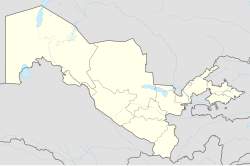Loading AI tools
Rishton (Uzbek: Rishton, Tajik: Рештон, Russian: Риштан, alternative spellings Rishtan, Rishdan, Roshidon, previously called also Kyubishev by Russians) is a city in Fergana Region, in Uzbekistan. It is the administrative center of Rishton District.[2] Its population is 34,800 (2016).[1] It is located about halfway between Kokand and Fergana. Main languages spoken in this area are Tajik and Uzbek.
Rishton
Rishton / Риштан | |
|---|---|
| Coordinates: 40°21′24″N 71°17′05″E | |
| Country | |
| Region | Fergana Region |
| District | Rishton District |
| Elevation | 471 m (1,545 ft) |
| Population (2016)[1] | |
| • Total | 34,800 |
| Website | www.rishton.uz |

Rishton is the most famous for, and one of the oldest centers of, ceramics in Uzbekistan. A fine quality reddish-yellow clay deposit 1-1.5 meters deep and 0.5-1.5 meters thick underlies almost the whole Rishton area. The clay can be used without refinement or addition of other types of clay from other regions. Besides clay, the potters of Rishton extracted various dyes, quartz sand, and fire clay from the surrounding the mountains. The special "ishkor" blue glaze is manufactured by natural mineral pigments and mountain ash plants.[3] The Khoja Ilgor Mosque was built in 1905 by craftsmen Eshonkhon and Noribai.[4][5]
Recent studies of scientists have established that the anthropological type of Uzbeks and Tajiks was formed at the end of the I millennium BC in the valleys of the middle and lower reaches of the Sayxun and spread to the valleys of Fergana, Khwarazm and Zarafshon in the II-III centuries AD. The ancient ancestors of these ethnic groups were the Sakas,[6][7][8][9] Massageteans,[10] Tocharians.[11] (according to Chinese sources yuezhi). The process of their formation was influenced by Turkic nationalities, nomadic from the north to the Interfluve, Persian-speaking tribes from the south of the Amu Darya at the end of the I millennium BC and at the beginning of the I millennium AD. Significant influence was exerted by Xionites, Kidarites, and Hephthalites in the IV-V centuries.[12][13][14]
In 1882, 17,970 people lived in the parish (of whom 4,900 lived in the parish center of Rishtan), and in 1909, 21,811 people lived there (of whom 6,415 lived in the parish center).[15] The population consisted of Uzbeks, Sarts, Tajiks and Kyrgyz, among others. The number of Russians according to these data did not exceed 10 people. Tajiks were the main population of the administrative center of Rishtan volost, Qala e Naw village, Kashkaryan village (Kashkaryon), the rest of the villages were mainly inhabited by Sarts, Uzbeks and other various Turkicized Mongolian tribes, Turkicized Persian-speaking indigenous population, etc.[16][17]
In 1909 Rishtan parish was a part of Bashkir district, 21,811 people lived in the parish. In this table, in addition to the villages of Rishtan parish, there are some villages of Zadiyan parish, which are now part of Rishtan district.
Khoja Ilgor Mosque is an architectural monument located in Rishtan (Fergana Region, Uzbekistan).[18] It was built in 1905 and was constructed in the Islamic architectural style. The Hodja Ilgor Mosque is a typical example of the Fergana multi-column, frontally opened cultic building. It is currently a functioning mosque. Presently, it is included in the list of Uzbekistan's nationally significant cultural heritage sites.[19]
Hanafi scholar Burhan al-Din al-Marghinani, the author of the book al-Hidayah, was born in this small town and grew up in neighbouring Margilan.[20]
Wikiwand in your browser!
Seamless Wikipedia browsing. On steroids.
Every time you click a link to Wikipedia, Wiktionary or Wikiquote in your browser's search results, it will show the modern Wikiwand interface.
Wikiwand extension is a five stars, simple, with minimum permission required to keep your browsing private, safe and transparent.
